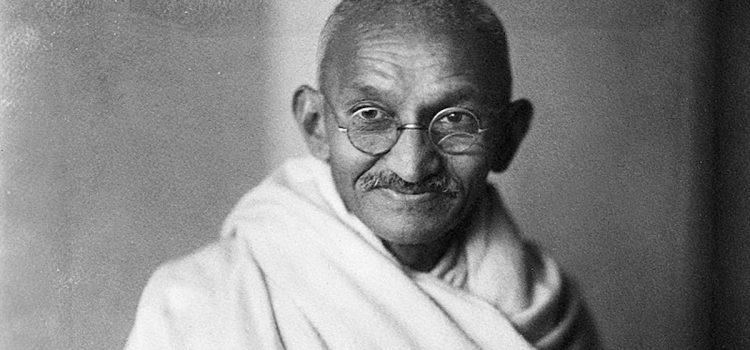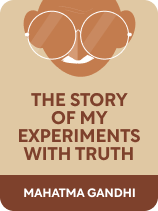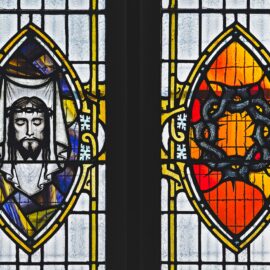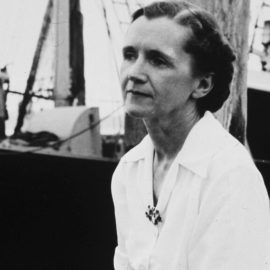

This article is an excerpt from the Shortform book guide to "The Story of My Experiments with Truth" by Mahatma Gandhi. Shortform has the world's best summaries and analyses of books you should be reading.
Like this article? Sign up for a free trial here.
Is there more to Gandhi’s nonviolent activism than meets the eye? What drove his relentless pursuit of Truth?
For Mahatma Gandhi, Truth was the prime mover in his life; his quest for Truth shaped his life’s work and philosophy. Gandhi’s autobiography reveals the personal journey behind his public actions, exploring his experiments with nonviolence, celibacy, and dietary restrictions.
Keep reading to understand how Gandhi’s search for Truth influenced his approach to both lifestyle and justice.
Mahatma Gandhi on Truth
To Mahatma Gandhi, Truth was the only god—the supreme and unchanging foundation of morality and justice. The title of his autobiography—The Story of My Experiments With Truth—refers to his search for justice and morality, or what he calls “Truth” with a capital “T.” His search for Truth led him to practice nonviolence and to lead an austere lifestyle renouncing sex and indulgent food.
(Shortform note: Although Gandhi believed that Truth was the only god, he was raised in the Hindu faith—a religion with many gods and goddesses—and drew inspiration from Hinduism in his spiritual practice. However, his experiments included learning about other religions. This coincides with his belief that “Truth” is whatever your inner voice speaks to you, which suggests that the individual is the final authority on what Truth is, more than any specific cultural or religious belief. We’ll use Gandhi’s “Truth” with a capital “T” to distinguish his concept from the uncapitalized word “truth” as in the phrase “tell the truth.”)
Gandhi’s Foundation in Truth
Although Mohandas claims that he was unremarkable as a child, the makings of his future leadership were already there. Although he was shy, struggled to make friends, and didn’t achieve great results at school, he developed a strong sense of duty early on, as well as a commitment to honesty—a precursor of his search for Truth. For example, he read a book about devoutness to one’s parents that deeply affected him and made him wish to be a deeply devoted son, just like the main character of the story. He also saw a play that instilled in him the virtue of truthfulness. He remembers imagining himself as the main character, upholding truth at all costs—both the truth of a situation and the Truth within oneself.
Gandhi’s Pursuit of Truth
Gandhi’s public actions as a political leader and nonviolent activist expressed a private concern: his constant search for justice and morality, or Truth. He argues that he devoted his life to pursuing Truth because it was the only certainty in an uncertain world, and it gave him peace of mind to know that he was always striving for it. We’ll explain Gandhi’s efforts to discover Truth through ahimsa (nonviolence) and brahmacharya—the pursuit of enlightenment through purity.
(Shortform note: Gandhi’s experience searching for Truth speaks to a core question of morality: Is it personal or collective? In The Happiness Hypothesis, Jonathan Haidt argues that modern ideas of morality focus on the individual’s freedom to choose the most moral course of action. But the lack of a shared moral framework can make us feel untethered. This might explain why Gandhi thought that the world was so uncertain and why he reached for a universal Truth to feel moored. Haidt also argues we should embrace a morality based on group norms because a diversity of morals means no morals. Gandhi’s political activism was arguably a way to rally collective morality around what he decided was key: nonviolence.)
Nonviolence (Ahimsa)
Gandhi believed that one could only reach Truth through nonviolence or ahimsa because violence was antithetical to Truth. Gandhi explains that humans can’t avoid causing harm—himsa—to others. For example, we harm animals and plants to eat, and we participate in societal himsa, like war.
We’ll first discuss how for Gandhi, practicing ahimsa meant being kind and not harming living beings. Next, we’ll explore how Gandhi handled a situation when it was impossible to be completely free from himsa.
Gandhi sought to practice nonviolence in every aspect of his life, including the following ways:
Nursing the sick and wounded
Gandhi enjoyed taking care of others. He believed this service should be provided gladly—not by obligation. He happily nursed family members and strangers when they were sick or hurt.
Not harming insects or dangerous animals
Gandhi believed in protecting the lives of all living creatures. For example, he founded an ashram, a home for families who wanted to practice ahimsa and live simply off the land. There were snakes on the land, but he never allowed anyone to kill them, even though they lived in tents with young children while they built their houses. The snakes never bit them, which Gandhi attributed to God’s protection.
Being a strict vegetarian
Safeguarding animals also meant not eating meat. Gandhi was raised vegetarian, and he later decided to stop eating eggs—which he equated to eating meat. He also stopped drinking milk due to the violent way farmers extracted it from animals.
Dilemmas of Ahimsa
Despite his profound commitment to ahimsa, Gandhi admits his efforts were imperfect. For instance, he describes the challenges of practicing ahimsa when volunteering for the British Empire’s ambulance service during the South Africa War and World War I.
Gandhi explains that he was caught between two duties: pursuing ahimsa and improving the situation of his people. Pursuing ahimsa would’ve meant trying to stop the conflict, which he felt he wasn’t strong enough to do. Simply staying out of the conflict wouldn’t count as practicing ahimsa because, by living under the protection of the British Empire, he was already participating in its violence.
Since he was already involved in the himsa, he used the opportunity to further his goals for India. He believed that volunteering in the war would help him improve the situation of the Indian people. At that time, he thought that being part of the British Empire was good for India and that the British government would treat Indians better if they supported the war.
Brahmacharya
In addition to believing in nonviolence, Gandhi believed that having a pure mind and body was necessary to find Truth. A mind and body contaminated by harmful thoughts or elements, such as lust or meat, was more likely to commit violence, and therefore less likely to find Truth. Self-purification led him to brahmacharya—the pursuit of enlightenment through purity. Gandhi strived for self-purification through monogamy, celibacy, and diet, all of which he believed would help keep his body and mind clean and open to Truth.
Monogamy and Celibacy
Gandhi expresses his commitment to being a loyal husband to his wife, Kasturbai. However, he admits to having moments of being attracted to other women, which he felt deep shame about. He believes God intervened each time to save him from acting on the attraction. However, he explains that his commitment to being a loyal husband turned into jealousy. In the early years of their marriage, he was possessive and controlling.
His monogamy gradually became celibacy. After 18 years of marriage, he began practicing self-restraint to avoid having intercourse with his wife. At first, he wanted to prevent having more children because his activism was incompatible with family life. Five years later, he took a celibacy vow, which he described as freeing because it defended him against temptation. His self-restraint also helped his relationship with Kasturbai. Gandhi stopped seeing his wife as a sexual object, which helped him appreciate her personhood more fully.
Diet
Gandhi believed that controlling the quality and quantity of his food was as crucial for spiritual enlightenment as controlling his sexual desires. At first, his dietary choices were motivated by health concerns, but later they were influenced more by his philosophical beliefs. As a result, his diet leaned more toward fasting and restrictions:
- He avoided alcohol all his life.
- After being a vegetarian for many decades, he adopted a fruitarian diet. Later, he felt that this diet was too enjoyable and that eating should focus only on bodily sustenance.
- When he was imprisoned for refusing to comply with an unfair law in 1908, he realized that the rules for inmates—for example, they couldn’t have tea, coffee, and condiments—fit well with his brahmachari lifestyle. After his release, he continued following these restrictions.
- Following his mother’s example, he began fasting regularly. He believed that fasting tamed the senses, purified his mind, and made it easier to practice celibacy.
The Satyagraha Movement
Gandhi founded the Satyagraha movement—nonviolent resistance to the British Empire’s oppression of Indians. Satyagraha (from the Sanskrit words sat, meaning truth, and agraha, meaning steadfastness) involved resisting unfair or immoral situations through nonviolent action. The nonviolent actions he endorsed were mostly disobeying laws in a way that didn’t endanger or harm anyone.
The Amritsar Massacre marked a turning point in the movement. Gandhi’s response to the tragedy exemplified his commitment to satyagraha and to uncovering Truth. Other leaders urged Gandhi to go to Amritsar soon after the massacre—but the government forbade him, which further enraged the population. Instead of traveling to the Punjab despite the prohibition, Gandhi decided to wait. He knew the people were looking to him for leadership, and he believed that if he had taken bold action, the people of Punjab would have used that as a cue for more violent resistance.
Instead, he had multiple conversations with government officials and showed them that allowing him to be there to engage with the people would help bring peace to the situation. Eventually, the government allowed Gandhi to travel to Punjab, and he spent time getting to know the locals’ grievances—finding the factual truth behind the violent events that had taken place, as well as the Truth that would bring morality and justice back to the community. He learned how the British government had been oppressing them, including making them crawl on their hands and knees when they traversed a specific road.
Exercise: Reflect on Gandhi’s Pursuit of Truth
Gandhi’s autobiography gives a peek behind the curtain of his nonviolent activism. Think about what you’ve read and how it might change your views on Gandhi and his concept of Truth.
- Gandhi believed that a pure body and mind were necessary to discover Truth. Do you agree? Explain your answer.
- Gandhi believed that violence was antithetical to Truth, but he still engaged in himsa (for example, when he volunteered in Britain’s wars to help raise India’s profile within the Empire). What do you think is the role of violence in the search for truth and justice?

———End of Preview———
Like what you just read? Read the rest of the world's best book summary and analysis of Mahatma Gandhi's "The Story of My Experiments with Truth" at Shortform.
Here's what you'll find in our full The Story of My Experiments with Truth summary:
- Gandhi’s life story from childhood until adulthood
- How Gandhi became a world-famous activist
- A look at Gandhi’s commitment to a nonviolent, austere lifestyle






